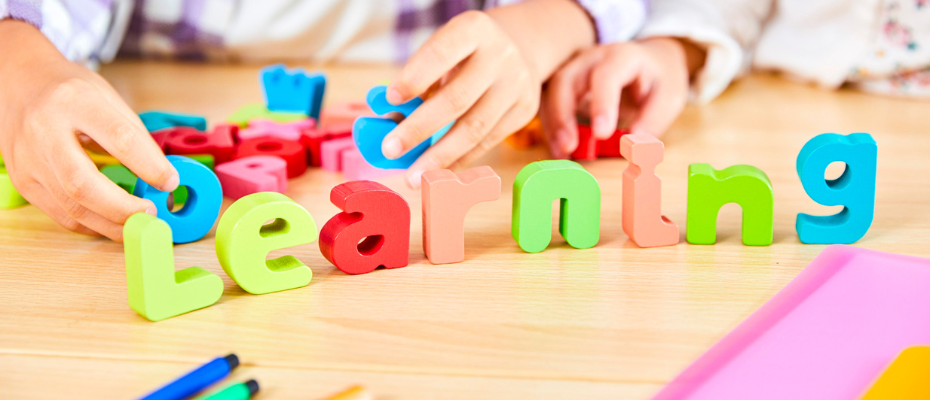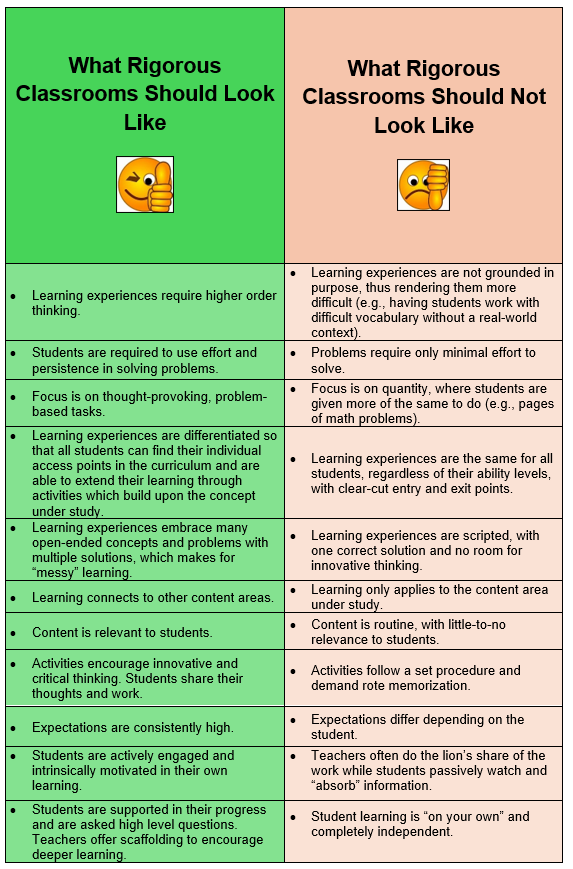Creating a Rigorous and Engaging Learning Environment

While the words “strict,” “severe,” and “harsh” are typically used in dictionary definitions to describe the word rigor, this term has a completely different connotation when applied to the field of education. Here, rigor has nothing to do with difficult assignments, a greater quantity of work, or working longer amounts of time. Brian Sztabnik (2015) sums up the true meaning of rigor in the classroom as, “…the result of work that challenges students’ thinking in new and interesting ways.” In a nutshell, rigor means instructional practices that create learning experiences which require students to question their assumptions and think deeply and critically. Advocates of a rigorous classroom and curriculum contend that rigorous learning experiences that are appropriately tied to students’ abilities and interests will not only motivate and engage them to learn more information, but to learn that information more deeply. In the process, students also achieve a sense of accomplishment in overcoming a challenge — a clear indicator of intrinsic motivation. The goal of increasing rigor is to simultaneously increase students’ critical-thinking skills, which ultimately leads to individualized student engagement and success.
Rigor is Easily Misunderstood
Rigor is widely used in educational policy discussions and is associated with several state standards. However, it is often misunderstood, causing teachers to define it as “better.” The following chart illustrates what rigor is meant to look like in the classroom (as well as what it is not meant to look like).

Building a Rigorous and Engaging Learning Environment
A rigorous learning environment goes hand in hand with student engagement. Increasing rigor does not mean increasing one’s workload, but instead leading students to become intellectual problem solvers who are engaged and love to learn. Below is more information about some of the key aspects to help build a rigorous and engaging learning environment in the classroom.
Classroom Culture
The culture of a classroom is what sets rigor and engagement in motion. Teachers who have high expectations, well thought-out procedures, and a positive classroom environment have set the stage for rigor.
High Expectations
Teachers who expect the best from each student and who encourage all students to succeed to their best ability are not only great educators, but they are also guiding students to think about themselves in a positive light. Students who are encouraged to persevere through difficult concepts are even more engaged and encouraged when they succeed.
Questioning Techniques
As you design lessons that incorporate more rigorous and engaging opportunities for learning, be sure to pay attention to the types of questions that are being asked in the classroom. To promote students’ critical-thinking skills (and thus boost engagement), teachers should pay extra attention to the types of verbs used in their questions. Additionally, the questions being asked should be more open-ended, meaning the questions themselves should not be able to be answered with a simple “yes” or “no,” but rather, require elaboration on the part of students. For example, instead of providing students with a basic math question as a warm-up activity, opt instead to show a problem that has been solved incorrectly and then ask students where the thinking went wrong.
Growth Mindset
Growth mindset embraces the concept that students can and will eventually learn, but they’re not ready just yet. The basic premise of growth mindset is the idea that the brain is constantly evolving and developing. Therefore, our intelligence is not predetermined, nor is it set in stone. This groundbreaking idea was introduced by the renowned psychologist, Dr. Carol Dweck, whose research into student motivation, personality, and development sparked the topic in her 2006 book, Mindset: The New Psychology of Success.
If students are to learn deeply, they must engage — and even productively struggle — with the content. When students learn to seek out challenges so that they can put forth the effort to grow and change, they are able to overcome both academic and social-emotional obstacles, putting them on the path to true understanding. The teaching and modeling of a growth mindset instills the belief that students can do “hard things” (Senn, 2021).
A Multifaceted Process
As you are beginning to see, both rigor and student engagement are not only multifaceted, but they are a critical aspect to an effective learning environment. Creating a learning environment that ignites excitement, challenge, and interest, as well as initiates higher-level thinking in new and innovative ways is critical to guiding students to become engaged lifelong learners.
Are you curious? Want to take a deep dive on this topic?
To learn more about rigorous and engaging learning environments, visit the Professional Development Institute (PDI) website or our Boosting Student Engagement Using Active Learning Strategies course.
For over 27 years, PDI has provided high-quality and affordable online professional development courses to K-12 teachers worldwide. Our online courses are designed to offer practical strategies that can be implemented in classrooms immediately. All our courses are instructor-led and conducted entirely online. Graduate-level university credit for every PDI online course for teachers is available through the University of California San Diego Division of Extended Studies. PDI offers an extensive catalog of online courses that cover the most critical topics in today's classrooms.
References:
Dweck, C. S. (2006). Mindset: The New Psychology of Success. New York, NY: Ballantine Books
Senn, D. (2021). “The Ultimate Guide to Academic Rigor.” Learning Sciences International. Retrieved 30 Nov. 2022 from https://www.learningsciences.com/blog/academic-rigor/
Sztabnik, B. (2015). “A New Definition of Rigor.” Edutopia. Retrieved 20 Nov.2022 from https://www.edutopia.org/blog/a-new-definition-of-rigor-brian-sztabnik

View PDI's Catalog of Courses
Check out a list of all PDI graduate-level online courses or sort by grade level or subject area.

Register Now!
Quick access to register for PDI's online courses using our secure system.

Learn More about PDI
Find out how to reach PDI and get answers to any questions you may have.

Access My Course
Access PDI's online learning management system to begin your course.